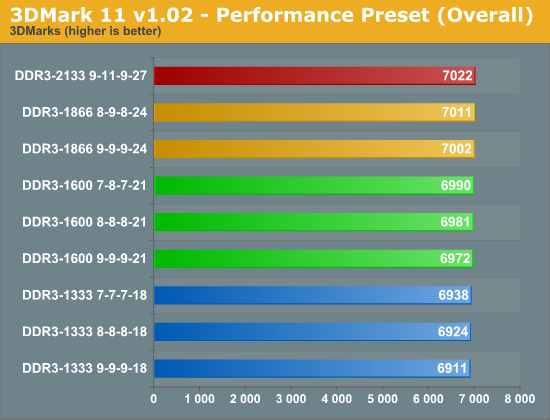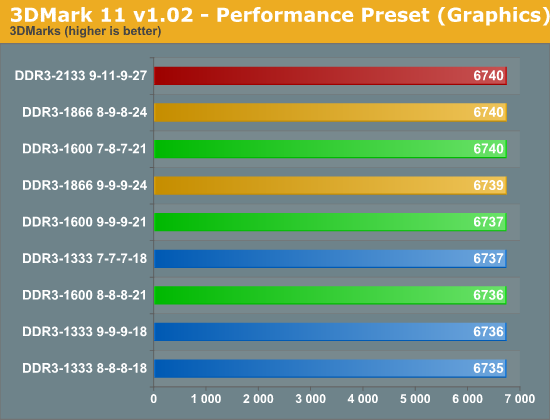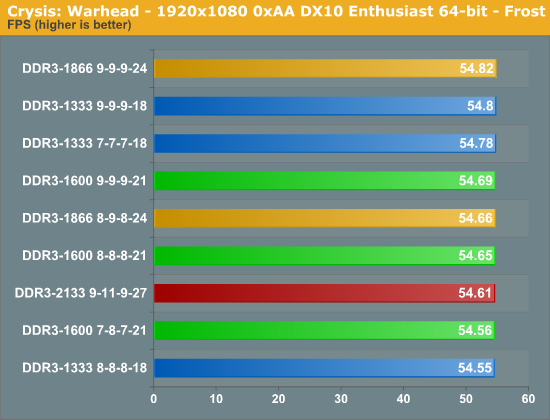Sandy Bridge Memory Scaling: Choosing the Best DDR3
by Jared Bell on July 25, 2011 1:55 AM EST3DMark 11
We're going to start the graphics benchmarks with the synthetic 3DMark test. The latest version, 3DMark 11, is still very GPU dependent. However, it does include a CPU Physics test and a combined graphics/physics test for simulating those types of loads. We’ll use the overall score with the three subtests to see if we can find any areas where memory performance makes a noticeable difference.




The overall score, which is heavily based on the graphics tests, shows a mere ~1% change across the board. When you get to the graphics test, you can see that the faster memory makes absolutely no difference at all. It's not until we get to the physics test where we see some improvement from increasing the memory speed. We get performance boost of up to 11% when going from DDR3-133 to DDR3-2133. The combined test entails the rendering of a 3D scene with the GPU while performing physics tasks on the CPU. Here again, were see a very small 2% increase in performance from the slowest to the fastest.
Crysis and Metro 2033
Based on 3DMark 11, then, we’d expect most games to show very little improvement from upgrading your memory, but we ran several gaming benchmarks just to be sure. I decided to combine the analysis for Crysis: Warhead and Metro 2033 due to the virtually non-existent differences observed during these tests. Crysis: Warhead was the previous king of the hill when it came to bringing video cards to their knees. The newer kid on the block, Metro 2033, has somewhat taken over that throne. Just how do they react to the various memory configurations we're testing today?
It's worth noting that the settings used here are the settings that I would actually play these games at: 1920x1080 with most of the high quality features enabled. Frame rates are well above 30, so definitely playable, though they’re below 60 so some would say they’re not perfectly smooth. Regardless, unless you play at settings where your GPU isn’t the primary bottleneck, you should see similar scaling from memory performance.


The results weren't very stimulating, were they? Just as expected, gaming with faster memory just doesn't make any notable difference. I could have potentially lowered the resolution and settings in an attempt to produce some sort of difference, but I felt that testing these games at the settings they're most likely to be played at was far more enlightening. If you want better gaming performance, the GPU is the best component to upgrade—no news there.










76 Comments
View All Comments
Rick83 - Monday, July 25, 2011 - link
Fancy heat spreaders are the worst that has ever happened to RAM.It gets worse when you have to pay more to get rid of it, as with the new low profile vengeance series from corsair.
Memory doesn't usually get that hot anyway, and the large heat spreaders impede airflow between the modules in fully populated setups, as well as limit what size your cooler can be, occasionally forcing you to get one of those water-cooler-in-a-box things which incur massive extra costs.
The only reason I don't want to have completely naked memory, is that the heat spreader gives the RAM some ESD protection, which is actually useful.
JoJoman88 - Monday, July 25, 2011 - link
The review just made your post the truest of them all jabber!Spacecomber - Monday, July 25, 2011 - link
In the past, one reason to get faster rated memory is that you eventually would see a migration of what was the standard memory module to something running on a faster bus speed. I'm not sure if that really holds true, anymore. It seems that these days you are more likely to see the adoption of a completely new type of memory, rather than an existing standard sticking around long enough for the minimum required memory speeds it is based on to go up.geofelt - Monday, July 25, 2011 - link
One of the price differentiators is the heat spreaders.Apart from the aesthetics, where is the value of fancy heat spreaders? Can it be measured?
Seems to me that they are mostly marketing gimmicks, excepting perhaps for those used on overclocking competitions.
I would like to see some sort of a study to determine the value of heat spreaders.
MrSpadge - Wednesday, July 27, 2011 - link
Short answer: nothing.MrS
BobDavid - Monday, July 25, 2011 - link
see subjectJarredWalton - Monday, July 25, 2011 - link
See the conclusion; we already did a look at that (with HD 3000 and Llano).http://www.anandtech.com/show/4476/amd-a83850-revi...
LoneWolf15 - Monday, July 25, 2011 - link
Ivy Bridge will be out next year. There is a reasonable chance it could have a bump in memory bandwidth. Buy RAM at one or two multipliers above what you need now, and when the upgrade comes along, you won't be wishing for new RAM.DDR3 is so cheap right now, it's worth planning ahead.
dman - Monday, July 25, 2011 - link
I've been looking for a review like this for a while, was a good read even if it didn't come as a huge surprise. I'm definitely interested in the AMD platform results if/when those are available.SteveSweetz - Monday, July 25, 2011 - link
I was disappointed to see this article lacked the detail (and quantity) of the gaming tests versus it's predecessor on AnandTech: http://www.anandtech.com/show/2792/10That article showed that memory frequency and latency changes had a greater impact in some games than others, and that in most cases the memory also had a greater impact on the minimum framerate (an important consideration) than average framerate.
Also disappointing to see no CAS6 sticks tested here. Particularly because 2GB 1600MHz CAS6 were relatively common at one point, but now, for whatever reason, G.Skill is the only company that still makes them. It'd be interesting to see if that's a meaningful exclusive. The previous article showed CAS latency being more important than frequency in some cases.